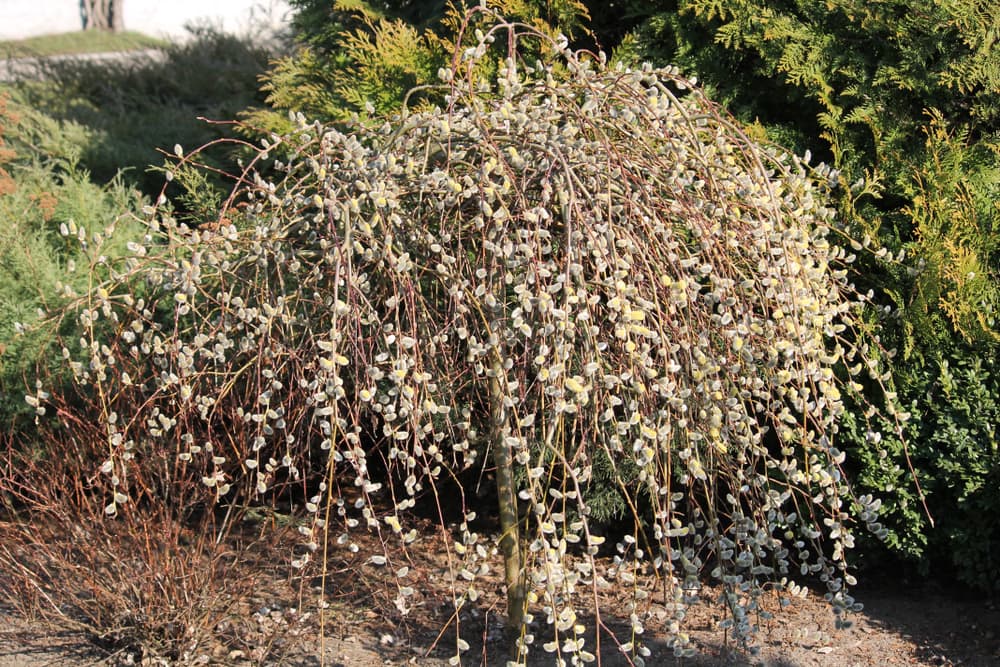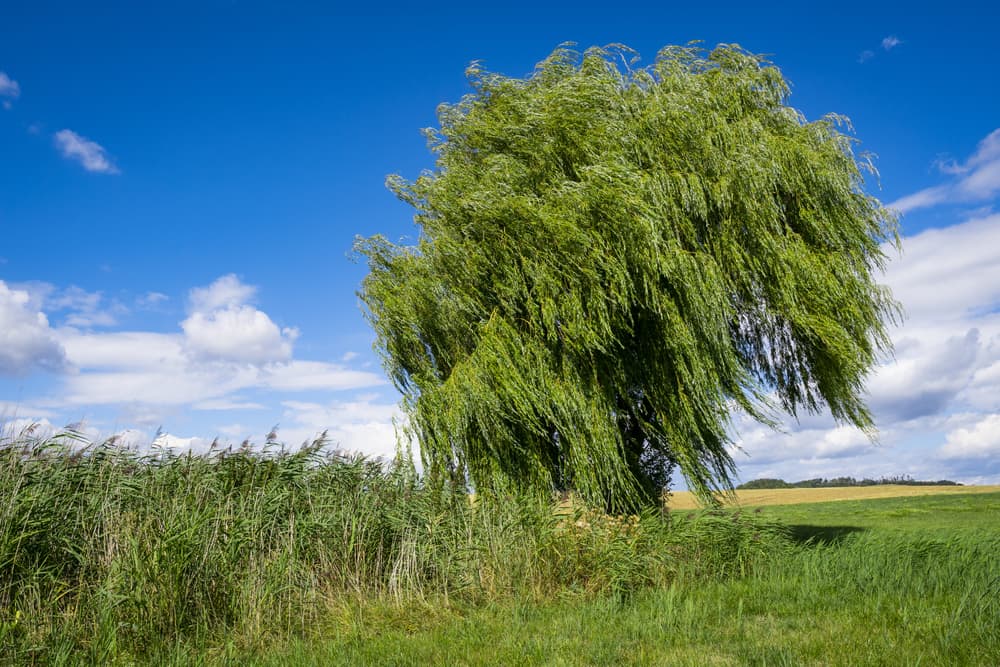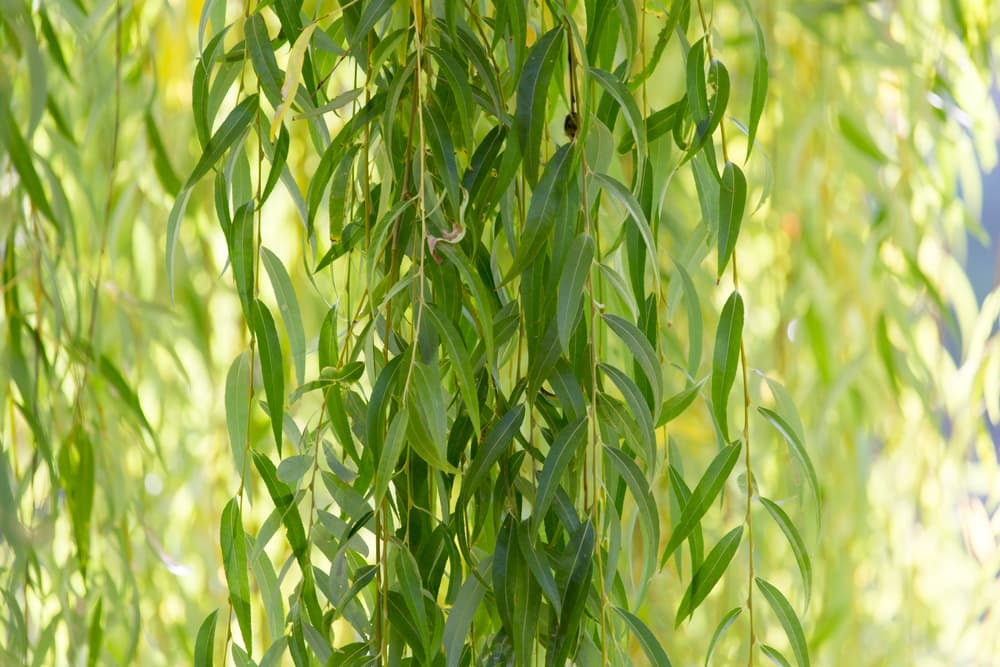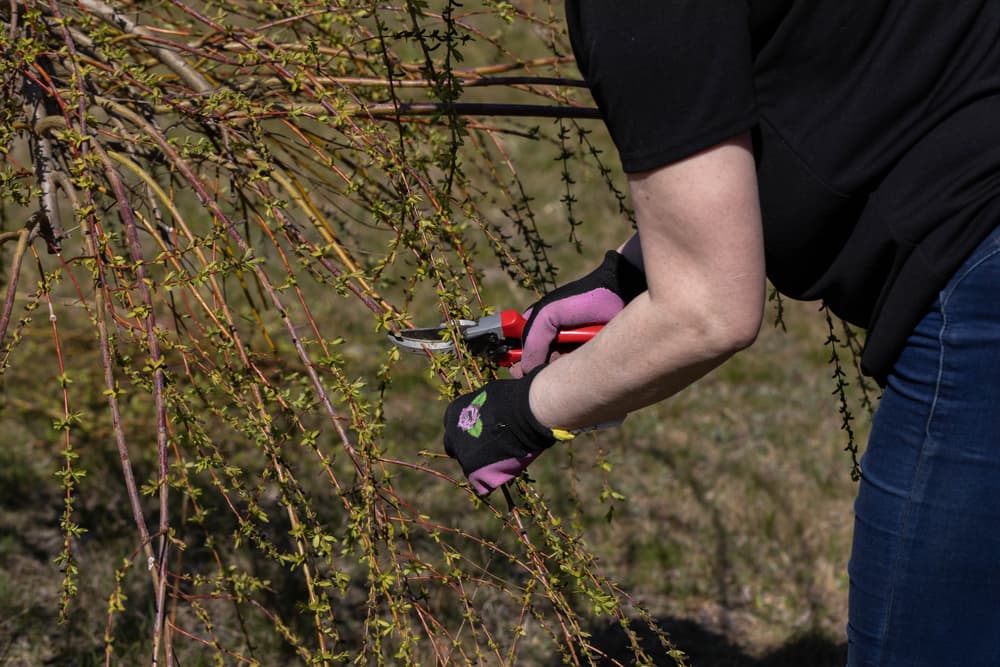Grow Weeping Willow Trees For Their Ornamental And Practical Value – Here’s How


Elizabeth is a Permaculture Garden Designer, Sustainability Consultant and Professional Writer, working as an advocate for positive change. She graduated from the University of St. Andrews with an MA in English and Philosophy and obtained a Diploma in Applied Permaculture Design from the Permaculture Association.
Reviewed By PETER LICKORISH

Peter is a Horticulture Lecturer and self-employed Horticulturist, with a passion for diverse areas of the industry - from garden design to the science behind plant growth and propagation. He has completed the Royal Horticultural Society’s Master of Horticulture (MHort) Award and lectures on RHS courses at Bedford College.
IN THIS GUIDE
WILLOW GUIDES
Container Growing
Pruning
Varieties
– Corkscrew
– Flamingo
– Weeping
Weeping willow are huge, beautiful trees which can find a place in many gardens.
Willow (Salix spp.) is a genus of trees that can come in a range of shapes, sizes and forms.
Weeping varieties are plants within this genus that have pendulous branches, which bend over and drape towards the ground.
Overview
| Plant Name | Weeping Willow |
| Common Types | Salix babylonica, Salix alba ‘Tristis’, Salix purpurea ‘Pendula’ etc. |
| Plant Type | Tree |
| Native Area | Temperate Northern Hemisphere |
| Hardiness Rating | H5-H6 |
| Foliage | Deciduous |
| Flowers | Various |
| When To Plant | January, February, March, November, December |
| Flowering Months | March, April |
| When To Prune | February, March |
Sunlight
Preferred
Full Sun or Partial Shade
Exposure
Exposed or Sheltered
Size
Height
1 – 12M+
Spread
1 – 8M+
Bloom Time
Spring
Soil
Preferred
Most soil types
Moisture
Moist but well-drained
pH
Any
When people talk about weeping willow, there are a number of different trees to which they could be referring.
S. babylonica

They are often referring to S. babylonica – a deciduous tree with weeping form.
They can grow to around 8-12m tall, with a similar width.
However, this tree does not usually thrive in the UK, and is now largely replaced with the below in cultivation.
S. alba ‘Tristis’

Another weeping willow is Salix x sepulcralis var. chrysocoma (also referred to as Salix alba ‘Tristis’). It is also sometimes referred to as ‘Golden Weeping Willow’.
This is a hybrid of our native white willow, and the above-mentioned Salix babylonica; it is common in parks and gardens and is one of the first willows to come into leaf, in March.
This is a large tree, which grows taller than 12m and wider than 8m.
S. purpurea ‘Pendula’
Purple weeping willow, S. purpurea ‘Pendula’ is another weeping willow to consider.
This is a fairly compact willow tree, which grows to around 3.5 x 2.5m.
S. caprea ‘Pendula’

The term ‘weeping willow’ can also refer to S. caprea ‘Pendula’, which goes by the names weeping goat willow, weeping pussy willow or Kilmarnock willow.
This is an even smaller tree more suited to smaller gardens which will grow to around 1.5-2.5m in both height and width.
S. integra ‘Pendula’

Another small tree is a dwarf weeping willow, S. integra ‘Pendula’, which has a compact height and width of just around 1.5 x 1m.
Why Grow Weeping Willow?
Weeping willows are extremely attractive ornamental trees.
Their pendulous form, along with their foliage and catkins produced in the spring make these very pretty trees to consider adding to a garden.
However, beyond their ornamental appeal, there are a range of other reasons to grow willows like these in your garden.
Willow bark can be used to make a rooting compound which is used to help cuttings to root more successfully.

The stems and bark are also very useful in basketry and in a range of other craft projects – and good charcoal can be made from the wood.
Beyond these uses, willow can also be useful in land management and in organic garden design – it can help in managing water and solving waterlogging issues.
Willows can also help to stabilise the soil with their vigorous and extensive root systems.
How To Grow A Weeping Willow
Willows all like moderately deep, fertile soils in full sun.

They tend to like moist conditions and some can cope well with waterlogged or even wetland margin sites.
They will often be positioned on a riverbank, or close to a garden pond.
They can cope with a wide range of different soil types and pH levels, and can cope with exposed sites.
Some even cope with maritime exposure and willows also tend to have good tolerance to atmospheric pollution.

One thing to note is that willows, especially larger weeping willows, have extensive and moisture-seeking roots which can cause problems with drains.
To play it safe do not place a weeping willow (especially a bigger one) too close to buildings, water pipes or a septic system.
Planting A Weeping Willow
Willows do not tend to respond well to transplanting, so care should be taken to plant them into their permanent positions as soon as possible.
Weeping willow trees are most frequently purchased as pot-grown specimens.
These can be planted out at any time of the year.
However, it is best to plant these out in spring or early autumn and to avoid planting during particularly hot and dry periods.
Willows can sometimes also be purchased as bare-root plants and planted out during the dormant period.

When planting a weeping willow, dig a hole that is the same depth as the root ball, and around twice as wide.
You can consider adding mycorrhizal fungi to the planting hole to aid establishment.
Firm a mix of the existing soil and compost back around the root ball, making sure that the willow is planted at the same depth as it was before.
Make sure that you do not bank up the soil around the base of the tree – mulch well with organic matter but make sure that this does not touch the trunk.
Weeping Willow Care
Watering
Weeping willow trees should be watered well during dry periods, especially during the first few months as they become established.
These trees will need more watering in summer, and less as temperatures fall.
Feeding
Your weeping willow should not require additional fertilisation as long as the soil is suitably nutritious and you mulch with organic matter.
Replenish the mulch around your weeping willow each spring to maintain fertility.
Protection
It is important to keep the area around a young weeping willow tree free from competing weeds and grass for the first couple of growing seasons.

However, as when planting anything else in your garden, you should think holistically and consider the other plants which could be placed close by to form guilds of companion plants that will help keep your willow tree healthy and create a resilient ecosystem.
If you live in an area with rabbits or deer, using a tree guard for the first couple of years after planting will be a good idea.
Pruning
Do not prune a young weeping willow for its first year.
After this, you can prune damaged or diseased branches at any time of the year – to encourage a clear stem, prune lower branches off the lower portion of the main trunk in the winter months, during the dormant period.

Weeping willows fall into RHS pruning group 1.1RHS Pruning groups. (n.d.-b). Royal Horticultural Society. Retrieved March 27, 2023, from https://www.rhs.org.uk/pruning/rhs-pruning-groups
They naturally form a well-balanced framework and need little pruning, if any at all.
However, they can also be hard pruned to rejuvenate an older specimen, or pollarded if desired.
“Many of the smaller weeping willows are top-grafted, meaning a piece of the weeping variety is effectively biologically welded to a more upright rootstock tree at a height of around 1m to allow it to cascade,” says Master Horticulturist Peter Lickorish.
“For this reason, the hard pruning of weeping willows is generally best avoided and pruning below the graft level will mean you ultimately end up with a different tree!”
Weeping willows are beautiful and useful trees – if you have a suitable spot in your garden, there may be a weeping willow that is right for you.
References
- 1RHS Pruning groups. (n.d.-b). Royal Horticultural Society. Retrieved March 27, 2023, from https://www.rhs.org.uk/pruning/rhs-pruning-groups
